|
| |

Pink Floyd is the premier space rock band. Since the mid-'60s, their music
relentlessly tinkered with electronics and all manner of special effects to push pop
formats to their outer limits. At the same time they wrestled with lyrical themes and
concepts of such massive scale that their music has taken on almost classical, operatic
quality, in both sound and words. Despite their astral image, the group was brought down
to earth in the 1980s by decidedly mundane power struggles over leadership and,
ultimately, ownership of the band's very name. After that time, they were little more than
a dinosaur act, capable of filling stadiums and topping the charts, but offering little
more than a spectacular recreation of their most successful formulas. Their latter-day
staleness cannot disguise the fact that, for the first decade or so of their existence,
they were one of the most innovative groups around, in concert and (especially) in the
studio.
While Pink Floyd are mostly known for their grandiose concept albums of the 1970s,
they started as a very different sort of psychedelic band. Soon after they first began
playing together in the mid-'60s, they fell firmly under the leadership of lead guitarist
Syd Barrett, the gifted genius who would write and sing most of their early material. The
Cambridge native shared the stage with Roger Waters (bass), Rick Wright (keyboards), and
Nick Mason (drums). The name Pink Floyd, seemingly so far-out, was actually derived from
the first names of two ancient bluesmen (Pink Anderson and Floyd Council). And at first,
Pink Floyd were much more conventional than the act into which they would evolve,
concentrating on the rock and R&B material that were so common to the repertoires of
mid-'60s British bands.
Pink Floyd quickly began to experiment, however, stretching out songs with wild
instrumental freak-out passages incorporating feedback; electronic screeches; and unusual,
eerie sounds created by loud amplification, reverb, and such tricks as sliding ball
bearings up and down guitar strings. In 1966, they began to pick up a following in the
London underground; on-stage, they began to incorporate light shows to add to the
psychedelic effect. Most importantly, Syd Barrett began to compose pop-psychedelic gems
that combined unusual psychedelic arrangements (particularly in the haunting guitar and
celestial organ licks) with catchy melodies and incisive lyrics that viewed the world with
a sense of poetic, child-like wonder.
The group landed a recording contract with EMI in early 1967 and made the Top 20 with
a brilliant debut single, "Arnold Layne," a sympathetic, comic vignette about a
transvestite. The follow-up, the kaleidoscopic "See Emily Play," made the Top
Ten. The debut album, The Piper at the Gates of Dawn, also released in 1967, may have been
the greatest British psychedelic album other than Sgt. Pepper's. Dominated almost wholly
by Barrett's songs, the album was a charming fun house of driving, mysterious rockers
("Lucifer Sam"); odd character sketches ("The Gnome"); childhood
flashbacks ("Bike," "Matilda Mother"); and freakier pieces with
lengthy instrumental passages ("Astronomy Domine," "Interstellar
Overdrive," "Pow R Toch") that mapped out their fascination with space
travel. The record was not only like no other at the time; it was like no other that Pink
Floyd would make, colored as it was by a vision that was far more humorous, pop-friendly,
and lighthearted than those of their subsequent epics.
The reason Pink Floyd never made a similar album was that Piper was the only one to be
recorded under Barrett's leadership. Around mid-1967, the prodigy began showing
increasingly alarming signs of mental instability. Barrett would go catatonic on-stage,
playing music that had little to do with the material, or not playing at all. An American
tour had to be cut short when he was barely able to function at all, let alone play the
pop star game. Dependent upon Barrett for most of their vision and material, the rest of
the group was nevertheless finding him impossible to work with, live or in the studio.
Around the beginning of 1968, guitarist Dave Gilmour, a friend of the band who was
also from Cambridge, was brought in as a fifth member. The idea was that Gilmour would
enable the Floyd to continue as a live outfit; Barrett would still be able to write and
contribute to the records. That couldn't work either, and within a few months Barrett was
out of the group. Pink Floyd's management, looking at the wreckage of a band that was now
without its lead guitarist, lead singer, and primary songwriter, decided to abandon the
group and manage Barrett as a solo act.
Such calamities would have proven insurmountable for 99 out of 100 bands in similar
predicaments. Incredibly, Pink Floyd would regroup and not only maintain their popularity,
but eventually become even more successful. It was early in the game yet, after all; the
first album had made the British Top Ten, but the group were still virtually unknown in
America, where the loss of Syd Barrett meant nothing to the media. Gilmour was an
excellent guitarist, and the band proved capable of writing enough original material to
generate further ambitious albums, Waters eventually emerging as the dominant composer.
The 1968 follow-up to Piper at the Gates of Dawn, A Saucerful of Secrets, made the British
Top Ten, using Barrett's vision as an obvious blueprint, but taking a more formal, somber,
and quasi-classical tone, especially in the long instrumental parts. Barrett, for his
part, would go on to make a couple of interesting solo records before his mental problems
instigated a retreat into oblivion.
Over the next four years, Pink Floyd would continue to polish their brand of
experimental rock, which married psychedelia with ever-grander arrangements on a Wagnerian
operatic scale. Hidden underneath the pulsing, reverberant organs and guitars and
insistently restated themes were subtle blues and pop influences that kept the material
accessible to a wide audience. Abandoning the singles market, they concentrated on
album-length works, and built a huge following in the progressive rock underground with
constant touring in both Europe and North America. While LPs like Ummagumma (divided into
live recordings and experimental outings by each member of the band), Atom Heart Mother (a
collaboration with composer Ron Geesin), and More... (a film soundtrack) were erratic,
each contained some extremely effective music.
By the early '70s, Syd Barrett was a fading or nonexistent memory for most of Pink
Floyd's fans, although the group, one could argue, never did match the brilliance of that
somewhat anomalous 1967 debut. Meddle (1971) sharpened the band's sprawling epics into
something more accessible, and polished the science fiction ambience that the group had
been exploring ever since 1968. Nothing, however, prepared Pink Floyd or their audience
for the massive mainstream success of their 1973 album, Dark Side of the Moon, which made
their brand of cosmic rock even more approachable with state-of-the-art production; more
focused songwriting; an army of well-time stereophonic sound effects; and touches of
saxophone and soulful female backup vocals.
Dark Side of the Moon finally broke Pink Floyd as superstars in the United States,
where it made number one. More astonishingly, it made them one of the biggest-selling acts
of all time. Dark Side of the Moon spent an incomprehensible 741 weeks on the Billboard
album chart. Additionally, the primarily instrumental textures of the songs helped make
Dark Side of the Moon easily translatable on an international level, and the record became
(and still is) one of the most popular rock albums worldwide.
It was also an extremely hard act to follow, although the follow-up, Wish You Were
Here (1975), also made number one, highlighted by a tribute of sorts to the long-departed
Barrett, "Shine on You Crazy Diamond." Dark Side of the Moon had been dominated
by lyrical themes of insecurity, fear, and the cold sterility of modern life; Wish You
Were Here and Animals (1977) developed these morose themes even more explicitly. By this
time Waters was taking a firm hand over Pink Floyd's lyrical and musical vision, which was
consolidated by The Wall (1979).
The bleak, overambitious double concept album concerned itself with the material and
emotional walls modern humans build around themselves for survival. The Wall was a huge
success (even by Pink Floyd's standards), in part because the music was losing some of its
heavy-duty electronic textures in favor of more approachable pop elements. Although Pink
Floyd had rarely even released singles since the late '60s, one of the tracks,
"Another Brick in the Wall," became a transatlantic number one. The band had
been launching increasingly elaborate stage shows throughout the '70s, but the touring
production of The Wall, featuring a construction of an actual wall during the band's
performance, was the most excessive yet.
In the 1980s, the group began to unravel. Each of the four had done some side and solo
projects in the past; more troublingly, Waters was asserting control of the band's musical
and lyrical identity. That wouldn't have been such a problem had The Final Cut (1983) been
such an unimpressive effort, with little of the electronic innovation so typical of their
previous work. Shortly afterward, the band split up; for a while. In 1986, Waters was
suing Gilmour and Mason to dissolve the group's partnership (Wright had lost full
membership status entirely); Waters lost, leaving a Roger-less Pink Floyd to get a Top
Five album with Momentary Lapse of Reason in 1987. In an irony that was nothing less than
cosmic, about 20 years after Pink Floyd shed its original leader to resume its career with
great commercial success, they would do the same again to his successor. Waters released
ambitious solo albums to nothing more than moderate sales and attention, while he watched
his former colleagues (with Wright back in tow) rescale the charts.
Pink Floyd still had a huge fan base, but there's little that's noteworthy about their
post-Waters output. They knew their formula, could execute it on a grand scale, and could
count on millions of customers - many of them unborn when Dark Side of the Moon came out,
and unaware that Syd Barrett was ever a member - to buy their records and see their
sporadic tours. The Division Bell, their first studio album in seven years, topped the
charts in 1994 without making any impact on the current rock scene, except in a marketing
sense. Ditto for the live Pulse album, recorded during a typically elaborately staged 1994
tour, which included a concert version of The Dark Side of the Moon in its entirety.
Waters' solo career sputtered along, highlighted by a solo recreation of The Wall,
performed at the site of the former Berlin Wall in 1990, and released as an album. Syd
Barrett continued to be completely removed from the public eye except as a sort of
archetype for the fallen genius.
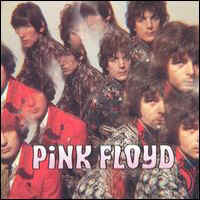
The Piper At The Gates Of Dawn - 1967
The title of Pink Floyd's debut album is taken from a chapter in Syd Barrett's favorite
children's book, The Wind in the Willows, and the lyrical imagery of The Piper at the
Gates of Dawn is indeed full of colorful, childlike, distinctly British whimsy, albeit
filtered through the perceptive lens of LSD. Barrett's catchy, melodic acid pop songs are
balanced with longer, more experimental pieces showcasing the group's instrumental
freak-outs, often using themes of space travel as metaphors for hallucinogenic experiences
- "Astronomy Domine" is a poppier number in this vein, but tracks like
"Interstellar Overdrive" are some of the earliest forays into what has been
tagged space rock. But even though Barrett's lyrics and melodies are mostly playful and
humorous, the band's music doesn't always bear out those sentiments - in addition to Rick
Wright's eerie organ work, dissonance, chromaticism, weird noises, and vocal sound effects
are all employed at various instances, giving the impression of chaos and confusion
lurking beneath the bright surface. The Piper at the Gates of Dawn successfully captures
both sides of psychedelic experimentation - the pleasures of expanding one's mind and
perception, and an underlying threat of mental disorder and even lunacy; this duality
makes Piper all the more compelling in light of Barrett's subsequent breakdown, and ranks
it as one of the best psychedelic albums of all time. - Steve Huey
01 - (4:16) Astronomy Domine
02 - (3:11) Lucifer Sam
03 - (3:12) Matilda Mother
04 - (2:50) Flaming
05 - (4:31) Pow R. Toc H.
06 - (3:10) Take Up Thy Stethoscope And Walk
07 - (9:49) Interstellar Overdrive
08 - (2:18) The Gnome
09 - (3:46) Chapter 24
10 - (2:15) The Scarecrow
11 - (3:24) Bike

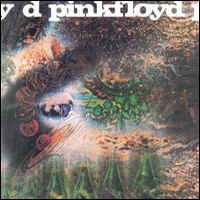
A Saucerful Of Secrets - 1968
A transitional album on which the band moved from Barrett's relatively concise and
vivid songs to spacy, ethereal material with lengthy instrumental passages. Barrett's
influence is still felt (he actually did manage to contribute one track, the jovial
"Jugband Blues"), and much of the material retains a gentle, fairy-tale
ambience. "Remember a Day" and "See Saw" are highlights; on "Set
The Controls for the Heart of the Sun," "Let There Be More Light," and the
lengthy instrumental title track, the band begin to map out the dark and repetitive pulses
that would characterize their next few records. - Richie Unterberger
1 - (5:42) Let There Be More Light
2 - (4:38) Remember A Day
3 - (5:33) Set The Controls For The Heart Of The Sun
4 - (4:17) Corporal Clegg
5 - (12:03) A Saucerful Of Secrets
6 - (4:41) See Saw
7 - (3:01) Jugband Blues

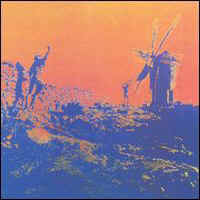
More - 1969
Commissioned as a soundtrack to the seldom-seen French hippie movie of the same name,
More was a Floyd album in its own right, reaching the Top 10 in Britain. The group's
atmospheric music was a natural for movies, but when assembled for record, these pieces
were unavoidably a bit patchwork, ranging from folky ballads to fierce electronic
instrumentals to incidental mood music. Several of the tracks are pleasantly
inconsequential, but this record does include some strong compositions, especially
"Cymbaline," "Green Is The Colour," and "The Nile Song." All
of these developed into stronger pieces in live performances, and better, high-quality
versions are available on numerous bootlegs. - Richie Unterberger
01 - (5:23) Cirrus Minor
02 - (3:31) The Nile Song
03 - (3:38) Crying Song
04 - (2:16) Up The Khyber
05 - (3:02) Green Is The Colour
06 - (4:55) Cymbaline
07 - (1:10) Party Sequence
08 - (5:35) Main Theme
09 - (3:21) Ibiza Bar
10 - (2:17) More Blues
11 - (7:15) Quicksilver
12 - (1:09) A Spanish Piece
13 - (2:17) Dramatic Theme

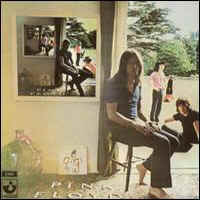
Ummagumma - 1969
For many years, this double LP/CD was one of the most popular albums in Pink Floyd's
pre-Dark Side of the Moon output, containing a live disc and a studio disc all for the
price of one (in the LP version). The live set, recorded in Birmingham and Manchester in
June 1969, is limited to four numbers, all drawn from the group's first two LPs or their
then recent singles. Featuring the band's second line-up (i.e., no Syd Barrett), the set
shows off a very potent group, their sound held together on stage by Nick Mason's
assertive drumming and Roger Waters' powerful bass work, which keep the proceedings moving
no matter how spaced out the music gets; they also sound like they've got the amplifiers
to make their music count, which is more than the early band had. "Astronomy
Domine," "Careful With That Axe Eugene," "Set the Controls for the
Heart of the Sun," and "A Saucerful of Secrets" are all superior here to
their studio originals, done longer, louder, and harder, with a real edge to the playing.
The studio disc was more experimental, each member getting a certain amount of space on
the record to make their own music - Richard Wright's "Sysyphus" was a pure
keyboard work, featuring various synthesizers, organs, and pianos; David Gilmour's
"The Narrow Way" was a three-part instrumental for acoustic and electric guitars
and electronic keyboards; and Nick Mason's "The Grand Vizier's Garden Party"
made use of a vast range of acoustic and electric percussion devices. Roger Waters'
"Grantchester Meadows" was a lyrical folk-like number unlike almost anything
else the group ever did. In 1994 the album was remastered and reissued in a green
slipcase, in a version a lot louder and sharper (and cheaper) than the original CD
release. - Bruce Eder
Disc 1
1 - (8:35) Astronomy Domine
2 - (8:56) Careful With That Axe, Eugene [Instrumental]
3 - (9:18) Set The Controls For The Heart Of The Sun
4 - (12:53) A Saucerful Of Secrets
Disc 2
1 - (13:42) Sysyphus
2 - (7:25) Grantchester Meadows
3 - (5:04) Several Species Of Small Furry Animals Gathered Togher In A Cave And Grooving
With A Pict
4 - (12:25) The Narrow Way
5 - (8:48) The Grand Vizier's Garden Party

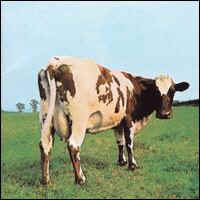
Atom Heart Mother - 1970
Appearing after the sprawling, unfocused double-album set Ummagumma, Atom Heart Mother
may boast more focus, even a concept, yet that doesn't mean it's more accessible. If
anything, this is the most impenetrable album Pink Floyd released while on Harvest, which
also makes it one of the most interesting of the era. Still, it may be an acquired taste
even for fans, especially since it kicks off with a side-long, 23-minute extended
orchestral piece that may not seem to head anywhere, but is often intriguing, more in what
it suggests than what it achieves. Then, on the second side, Roger Waters, David Gilmour,
and Rick Wright have a song apiece, winding up with the group composition "Alan's
Psychedelic Breakfast" wrapping it up. Of these, Waters begins developing the voice
that made him the group's lead songwriter during their classic era with "If,"
while Wright has an appealingly mannered, very English psychedelic fantasia on
"Summer 68," and Gilmour's "Fat Old Sun" meanders quietly before
ending with a guitar workout that leaves no impression. "Alan's Psychedelic
Breakfast," the 12-minute opus that ends the album, does the same thing, floating for
several minutes before ending on a drawn-out jam that finally gets the piece moving. So,
there are interesting moments scattered throughout the record, and the work that initially
seems so impenetrable winds up being Atom Heart Mother's strongest moment. That it lasts
an entire side illustrates that Pink Floyd was getting better with the larger picture
instead of the details, since the second side just winds up falling off the tracks, no
matter how many good moments there are. This lack of focus means Atom Heart Mother will
largely be for cultists, but its unevenness means there's also a lot to cherish here. -
Stephen Thomas Erlewine
1 - (23:48) Atom Heart Mother
2 - (4:33) If
3 - (5:35) Summer '68
4 - (5:18) Fat Old Sun
5 - (13:46) Alan's Psychedelic Breakfast

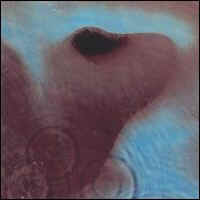
Meddle - 1971
Atom Heart Mother, for all its glories, was an acquired taste, and Pink Floyd wisely
decided to trim back its orchestral excesses for its follow-up, Meddle. Opening with a
deliberately surging "One of These Days," Meddle spends most of its time with
sonic textures and elongated compositions, most notably on its epic closer
"Echoes." If there aren't pop songs in the classic sense (even on the level of
the group's contributions to Ummagumma), there is a uniform tone, ranging from the
pastoral "A Pillow of Winds" to "Fearless," with its insistent refrain
hinting at latter-day Floyd. Pink Floyd were nothing if not masters of texture, and Meddle
is one of their greatest excursions into little details, pointing the way to the measured
brilliance of Dark Side of the Moon and the entire Roger Waters era. Here, David Gilmour
exerts a slightly larger influence, at least based on lead vocals, but it's not all
sweetness and light - even if its lilting rhythms are welcome, "San Tropez"
feels out of place with the rest of Meddle. Still, the album is one of the Floyd's most
consistent explorations of mood, especially from their time at Harvest, and it stands as
the strongest record they released between Syd's departure and Dark Side. - Stephen Thomas
Erlewine
1 - (6:01) One Of These Days
2 - (5:11) A Pillow Of Winds
3 - (6:07) Fearless
4 - (3:46) San Tropez
5 - (2:16) Seamus
6 - (23:35) Echoes


Obscured By Clouds - 1972
Obscured By Clouds is the soundtrack to the Barbet Schroeder film La Vallee, and it
plays that way. Of course, it's possible to make the argument that Pink Floyd's music of
the early '70s usually played as mood music, similar to film music, but it had structure
and a progression. Here, the instrumentals float pleasantly, filled with interesting
textures, yet they never seem to have much of a purpose. Often, they seem quite tied to
their time, either in their spaciness or in the pastoral folkiness, two qualities that are
better brought out on the full-fledged songs interspersed throughout the record. Typified
by "Burning Bridges" and "Wot's…uh the Deal," these songs explore
some of the same musical ground as those on Atom Heart Mother and Meddle, yet they are
more concise and have a stronger structure. But the real noteworthy numbers are the
surprisingly heavy blues-rocker "The Gold It's in The-," which, as good as it
is, is trumped by the stately, ominous "Childhood's End" and the jaunty pop tune
"Free Four," two songs whose obsessions with life, death, and the past clearly
point toward Dark Side of the Moon. ("Childhood's End" also suggests Dark Side
in its tone and arrangement.) As startlingly advanced as these last two songs are, they're
not enough to push the rest of Obscured by Clouds past seeming just like a soundtrack, yet
these tunes, blended with the sensibility of Meddle, suggest what Pink Floyd was about to
develop into. - Stephen Thomas Erlewine
01 - (3:08) Obscured By Clouds [Instrumental]
02 - (2:34) When You're In
03 - (3:33) Burning Bridges
04 - (3:11) The Gold It's In The
05 - (5:12) Wot's... Uh The Deal
06 - (4:21) Mudmen [Instrumental]
07 - (4:36) Childhood's End
08 - (4:19) Free Four
09 - (4:09) Stay
10 - (5:54) Absolutely Curtains [Instrumental]

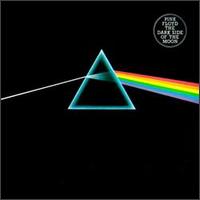
Dark Side Of The Moon - 1973
By condensing the sonic explorations of Meddle to actual songs and adding a lush,
immaculate production to their trippiest instrumental sections, Pink Floyd inadvertently
designed their commercial breakthrough with Dark Side of the Moon. The primary revelation
of Dark Side of the Moon is what a little focus does for the band. Roger Waters wrote a
series of songs about mundane, everyday details which aren't that impressive by
themselves, but when given the sonic backdrop of Floyd's slow, atmospheric soundscapes and
carefully placed sound effects, they achieve an emotional resonance. But what gives the
album true power is the subtly textured music, which evolves from ponderous,
neo-psychedelic art rock to jazz fusion and blues-rock before turning back to psychedelia.
It's dense with detail, but leisurely paced, creating its own dark, haunting world. Pink
Floyd may have better albums than Dark Side of the Moon, but no other record defines them
quite as well as this one. - Stephen Thomas Erlewine
1 - (4:01) Speak To Me - Breathe
2 - (3:34) On The Run
3 - (7:08) Time
4 - (4:45) The Great Gig In The Sky
5 - (6:33) Money
6 - (7:43) Us And Them
7 - (3:26) Any Colour You Like
8 - (3:51) Brain Damage
9 - (2:05) Eclipse

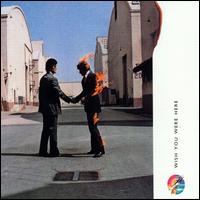
Wish You Were Here - 1975
Pink Floyd followed the commercial breakthrough of Dark Side of the Moon with Wish You
Were Here, a loose concept album about and dedicated to their founding member Syd Barrett.
The record unfolds gradually, as the jazzy textures of "Shine On You Crazy
Diamond" reveal its melodic motif, and in its leisurely pace, the album shows itself
to be a warmer record than its predecessor. Musically, it's arguably even more impressive,
showcasing the group's interplay and David Gilmour's solos in particular. And while it's
short on actual songs, the long, winding soundscapes are constantly enthralling. - Stephen
Thomas Erlewine
1 - (13:44) Shine On You Crazy Diamond Pts 1-5
2 - (7:33) Welcome To The Machine
3 - (5:10) Have A Cigar
4 - (5:36) Wish You Were Here
5 - (12:35) Shine On You Crazy Diamond Pts 6-9


Animals - 1977
Of all of the classic-era Pink Floyd albums, Animals is the strangest and darkest, a
record that's hard to initially embrace yet winds up yielding as many rewards as its
equally nihilistic successor, The Wall. It isn't that Roger Waters dismisses the human
race as either pigs, dogs, or sheep, it's that he's constructed an album whose music is as
bleak and bitter as that worldview. Arriving after the warm-spirited (albeit melancholy)
Wish You Were Here, the shift in tone comes as a bit of a surprise, and there are even
less proper songs here than on either Wish or Dark Side. Animals is all extended pieces,
yet it never drifts - it slowly, ominously works its way toward its destination. For an
album that so clearly is Waters', David Gilmour's guitar dominates thoroughly, with
Richard Wright's keyboards rarely rising above a mood-setting background (such as on the
intro to "Sheep"). This gives the music, on occasion, immediacy and actually
heightens the dark mood by giving it muscle. It also makes Animals as accessible as it
possibly could be, since it surges with bold blues-rock guitar lines and hypnotic space
rock textures. Through it all, though, the utter blackness of Waters' spirit holds true
and since there are no vocal hooks or melodies, everything rests on the mood, the
near-nihilistic lyrics, and Gilmour's guitar. These are the kinds of things that satisfy
cultists, and it will reward their attention - there's just no way in for casual
listeners. - Stephen Thomas Erlewine
1 - (1:28) Pigs On The Wing Pt. 1
2 - (17:13) Dogs
3 - (11:27) Pigs (Three Different Ones)
4 - (10:29) Sheep
5 - (1:29) Pigs On The Wing Pt. 2


The Wall - 1979
Roger Waters constructed The Wall, a narcissistic, double-album rock opera about an
emotionally crippled rock star who spits on an audience member daring to cheer during an
acoustic song. Given its origins, it's little wonder that The Wall paints such an
unsympathetic portrait of the rock star, cleverly named "Pink," who blames
everyone - particularly women - for his neuroses. Such lyrical and thematic shortcomings
may have been forgivable if the album had a killer batch of songs, but Waters took his
operatic inclinations to heart, constructing the album as a series of fragments that are
held together by larger numbers like "Comfortably Numb" and "Hey You."
Generally, the fully developed songs are among the finest of Pink Floyd's later work, but
The Wall is primarily a triumph of production: Its seamless surface, blending melodic
fragments and sound effects, makes the musical shortcomings and questionable lyrics easy
to ignore. But if The Wall is examined in depth, it falls apart, since it doesn't offer
enough great songs to support its ambition, and its self-serving message and shiny
production seem like relics of the late-'70s Me Generation. - Stephen Thomas Erlewine
Disc 1
01 - (3:21) In The Flesh
02 - (2:30) The Thin Ice
03 - (3:11) Another Brick In The Wall Pt 1
04 - (1:52) The Happiest Days Of Our Lives
05 - (4:01) Another Brick In The Wall Pt 2
06 - (5:38) Mother
07 - (2:49) Goodbye Blue Sky
08 - (2:09) Empty Spaces
09 - (3:32) Young Lust
10 - (3:39) One Of My Turns
11 - (4:18) Don't Leave Me Now
12 - (1:15) Another Brick In The Wall Pt 3
13 - (1:17) Goodbye Cruel World
Disc 2
01 - (4:43) Hey You
02 - (2:41) Is There Anybody Out There?
03 - (3:26) Nobody Home
04 - (1:34) Vera
05 - (1:27) Bring The Boys Back Home
06 - (6:26) Comfortably Numb
07 - (1:36) The Show Must Go On
08 - (4:19) In The Flesh
09 - (4:26) Run Like Hell
10 - (3:59) Waiting For The Worms
11 - (0:31) Stop
12 - (5:22) The Trial
13 - (1:45) Outside The Wall

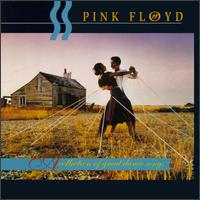
A Collection Of Great Dance Songs - 1981
Anyone who knew anything about Pink Floyd knew that a dance band they were not, so this
profit-taking, holiday-season compilation, courtesy of Columbia Records, was intended
ironically. Arguably the quintessential album band, Pink Floyd is not well-served by
compilations, especially one on which the two parts of "Shine On You Crazy
Diamond" are edited together and there's a re-recording of "Money." Stick
to the full-length versions. - William Ruhlmann
1 - (5:51) One Of These Days
2 - (6:48) Money
3 - (10:28) Sheep
4 - (10:44) Shine On You Crazy Diamond
5 - (5:27) Wish You Were Here
6 - (3:54) Another Brick In The Wall Pt 2

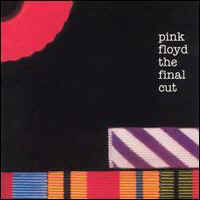
The Final Cut - 1983
The Final Cut extends the autobiography of The Wall, concentrating on Roger Waters'
pain when his father died in World War II. Waters spins this off into a treatise on the
futility of war, concentrating on the Falkland Islands, setting his blistering
condemnations and scathing anger to an impossibly subdued music that demands full
attention. This is more like a novel than a record, requiring total concentration since
shifts in dynamics, orchestration, and instrumentation are used as effect. This means that
while this has the texture of classic Floyd, somewhere between the brooding sections of
The Wall and the monolithic menace of Animals, there are no songs or hooks to make these
radio favorites. The even bent of the arrangements, where the music is used as texture,
not music, means that The Final Cut purposely alienates all but the dedicated listener.
Several of those listeners maintain that this is among Pink Floyd's finest efforts, and it
certainly is an achievement of some kind - there's not only no other Floyd album quite
like it, it has no close comparisons to anybody else's work (apart from Waters' own The
Pros and Cons of Hitch-Hiking, yet that had a stronger musical core). That doesn't make
this easier to embrace, of course, and it's damn near impenetrable in many respects, but
with its anger, emphasis on lyrics, and sonic textures, it's clear that it's the album
that Waters intended it to be. And it's equally clear that Pink Floyd couldn't have
continued in this direction - Waters had no interest in a group setting anymore, as this
record, which is hardly a Floyd album in many respects, illustrates. Distinctive, to be
sure, but not easy to love and, depending on your view, not even that easy to admire. -
Stephen Thomas Erlewine
01 - (3:04) The Post War Dream
02 - (4:25) Your Possible Pasts
03 - (1:29) One Of The Few
04 - (3:01) The Hero's Return
05 - (5:08) The Gunners Dream
06 - (3:53) Paranoid Eyes
07 - (1:21) Get Your Filthy Hands Off My Desert
08 - (4:14) The Fletcher Memorial Home
09 - (2:08) Southampton Dock
10 - (4:56) The Final Cut
11 - (5:07) Not Now John
12 - (5:19) Two Suns In The Sunset

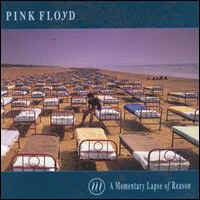
A Momentary Lapse Of Reason - 1987
A David Gilmour solo album in all but name, heavily featuring the kind of atmospheric
instrumental music and Gilmour guitar sound typical of the Floyd before the now-departed
Roger Waters took over but lacking Waters' unifying vision and lyrical ability. - William
Ruhlmann
01 - (4:26) Signs Of Life [Instrumental]
02 - (4:56) Learning To Fly
03 - (6:12) The Dogs Of War
04 - (5:09) One Slip
05 - (5:44) On The Turning Away
06 - (7:31) Yet Another Movie - Round And Around
07 - (1:48) New Machine Pt 1
08 - (6:20) Terminal Frost
09 - (0:40) New Machine Pt 2
10 - (8:50) Sorrow

|